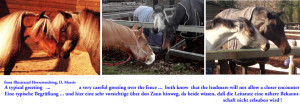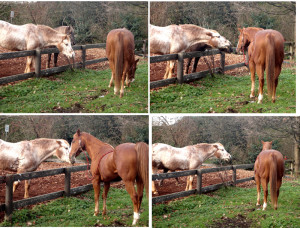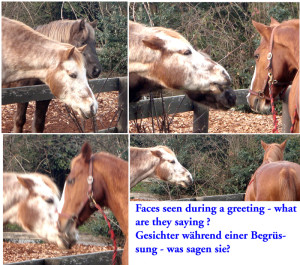Understand your Horse – Part 06
|
|
Ihr Pferd verstehen – Teil 06
|
- In the last part we got the first taste of the complexity of analysing the horse’s face and the mood it might express, because we recognized that it is always a number of components, which must be read as a whole. Looking at the eyes or the position of the ears alone will not tell you the story! Here a few further examples for this:
4. The grooming face:
- This is usually not so important for your communication with your horse, although it is a precious moment, when your horse approaches you with the intent of grooming you – a sure sign of friendship! However, grooming must be allowed by the higher-ranking partner – and that should be you.
- So: Grooming is offered – this is part of the horse etiquette! – this is done with “questioning ears”(more of that later), and in over 60% of the cases it is the lower ranking horse who initiates it by moving into position, which you can see on the left picture: standing parallel and close (a sure sign of friendship) and head to tail. The higher-ranking horse would either move away or allow the grooming.
|
|
- Im letzten Blog haben wir die erste Kostprobe von der Komplexität einer Analyse des Pferdegesichtes und seiner Ausdrucksformen bekommen, da wir bemerkt haben, daß es immer eine ganze Anzahl von Komponenten ist, die man als Ganzes lesen muß. Lediglich die Augen oder nur die Positionen der Ohren zu betrachten ist nicht genug. Hier ein paar weitere Beispiele:
4. Putzgesichter:
- Das ist für unsere Kommunikation mit dem Pferd nicht so wichtig, obwohl es ein rührender Moment ist, wenn Ihr Pferd sich mit der Absicht Sie zu putzen nähert – immer ein Zeichen von Freundschaft! Putzen muß jedoch vom höherrangigen Partner erlaubt werden – und das sollten Sie sein.
- Also: Putzen wird mit „fragenden Ohren“ (mehr davon später) angeboten – das gehört zur Pferdeetiquette! – und in über 60% der Fälle ist es das im Rang niedere Pferd, welches es einleitet, indem es sich in die Position begibt, die man hier links sehen kann: man steht dazu parallel und nah beieinander (ein Zeichen der Freundschaft) und Kopf an Schweif. Das höherrangige Pferd entfernt sich entweder oder erlaubt eine Putzpartie.
|
 Grooming faces – Putzgesichter
|
- Grooming sessions vary in length, which seems to depend on the depth of the friendship as well as the season. The longest ones occur in the spring and coincide with the shedding of the winter coat. Those sessions can go on for quite some time with some horses (the average length is reported to be about 3 minutes), but with others the sessions are very short. My own horses keep them so short that I have never caught a good one on camera yet! I groom them too well myself, perhaps, so longer sessions are not necessary for the function of cleaning and are then just a short reaffirmation of friendship.
- You can hardly mistake a grooming face, because you see the grooming activity, which is going on! Nevertheless it is very interesting to study the face in detail, as you can learn something about the mood-expression of eyes and ears! Especially since so many people believe that any ear position, other than the one curiously pointed to the front, carries some indication of aggression. Here the ears are turned sideways, and lowered somewhat, with the openings pointing down. The eyes are often half-closed – a loving grooming session is done with abandon! The mouth is of course very busy with the teeth showing under a crinkled nose.
- Horses groom their friends mainly in spots which are not easily accessible to themselves. Most sessions start at the mane, move to the withers and then along the neck. The shoulders and back, all the way to the top of the croup get attention too, sometimes also the flanks. In most cases the session will be ended by the higher-ranking horse.
- Grooming expresses a strong sense of belonging together and this is the reason (not only cleanliness!) why we should offer it often to our horses – and recognize, when our buddy initiates or offers it to us! Especially when establishing a relationship with a new horse you should move parallel and imitate the start of a grooming session by “finger-nibbling” at the base of his mane.
- One of the unforgettable highlights of my horse life was a peaceful evening in the shed with my three horses – me grooming one of them, who returned the favour to the next, who in turn started to nibble on number three – who closed the circle by grooming my backside! It was very harmonious – and very tickling indeed!
5. The greeting face:
- An interested Hello-Face is carried high on a convexly arched neck, the ears are pointed to the front, the eyes are open (but not wide) – then the head is stretched forward slowly. (A rapid approach goes against horse etiquette and is usually rebuffed.) Then the two blow air into each other’s nostrils, which can take up quite some time. This is NOT done to express the beginning of a friendship (although it can lead to one later), but rather to recognize and store the individual smell for future encounters in their memory. Therefore the greeting face is not identical to a loving face – and the reaction “look how cute they are together!” is a humanized one. It is much better to still beware, as the greeting can end in a sudden squeal and striking out, when the horses decide that they do NOT like each other!
- A greeting face expresses attention, interest, and perhaps curiosity, but not yet friendship.
|
|
- Diese kann ganz verschieden lang dauern, was offenbar von der Tiefe der Zuneigung und auch von der Jahreszeit abhängt. Am längsten putzt man sich im Frühling, wenn das Winterfell abgestoßen wird. Manche Pferde machen es ausgiebigst (im Durchschnitt liegt eine Putzpartie bei 3 Minuten), aber bei anderen sind sie sehr knapp bemessen. Meine eignen Pferde putzen sich so kurz, daß ich es noch nie mit der Kamera erwischt habe! Vielleicht bürste ich sie selber zu gut, so daß längere Partien für die Funktion der Säuberung nicht nötig sind, und sie dann nur noch als kurze Bestätigung der Freundschaft ausgeführt werden.
- Man kann ein Putzgesicht nicht mißverstehen, weil man ja die Aktivität des Putzens sieht. Aber dennoch ist es interessant, das Gesicht im Detail zu betrachten, da man etwas über den Ausdruck der Augen und Ohren lernen kann. Vor allem, da so viele Menschen meinen, daß alle Ohrpositionen, die nicht neugierig nach vorne gespitzt sind, aggressiv wären. Die Ohren sind hier seitlich gedreht und etwas abgeklappt und die Ohrmuscheln zeigen nach unten. Die Augen sind halbgeschlossen – eine liebevolle Putzpartie geschieht mit Hingabe! Das Maul ist natürlich beschäftigt und man kann die Zähne unter einer leicht gerümpften Nase sehen.
- Pferde putzen ihre Freunde hauptsächlich an Stellen, die sie selbst nicht gut erreichen können. Meistens fangen sie an der Mähne an, arbeiten sich zum Widerrist weiter und dann am Hals entlang. Auch die Schultern und der ganze Rücken bis zur Kruppe, manchmal auch die Flanken, kommen dran. In den meisten Fällen bricht das hochrangige Pferd die Sitzung ab.
- Putzen drückt ein starkes Zusammengehörig-keitsgefühl aus und wir sollten es aus diesem Grund (nicht nur wegen der Hygiene!) unseren Pferden oft bieten – und sollten erkennen können, wenn unser Freund es UNS anbietet! Vor allem, während man eine Beziehung mit einem neuen Pferd bildet, sollte man sich parallel aufstellen und den Beginn einer Putzpartie mit „Fingerknabbern“ an der Mähne imitieren.
- Einer der unvergeßlichen Höhepunkte in meinem Pferdeleben war ein friedlicher Abend im Stall mit meinen drei Pferden – ich putzte eins, was den Genuß an den nächsten weitergab, der wiederum am dritten zu knabbern anfing – und DER schloß den Kreis, indem er mich am Hinterteil putzte! Es war sehr harmonisch – und kitzlig!
5. Ein Begrüßungsgesicht:
- Ein interessiertes Hallo-Gesicht wird auf einem konvex gebogenen Hals getragen, mit nach vorn gespitzten Ohren und offenen (aber nicht aufgerissenen) Augen – dann wird der Hals langsam nach vorn ausgestreckt. (Eine zu schnelle Annäherung geht gegen die Etiquette und wird normalerweise abgewehrt.) Dann blasen sich die beiden gegenseitig mit den Nüstern an, was ziemlich lange dauern kann. Dies geschieht NICHT um Freundschaft auszudrücken (obwohl es später dazu kommen kann), sondern um den Individualgeruch des anderen zu erkennen und für die Zukunft im Gedächtnis zu speichern. Daher ist ein Begrüßungsgesicht nicht einem liebevollen Gesicht identisch – und die oft gehörte Reaktion “wie süß sie sind!” ist eine vermenschlichte. Es ist besser immer noch vorsichtig zu sein, da so eine Begrüßung schnell in einem Quietscher und vorn Ausschlagen enden kann, wenn die Pferde plötzlich entschließen, sich NICHT zu mögen!
- Ein Begrüßungsgesicht drückt Aufmerksamkeit, Interesse und vielleicht Neugierde aus, aber noch keine Freundschaft.
|

|
- So the ceremony of greeting consists of at least seven individual parts, which we recognize the whole as “greeting”. Most recognizable are the pricked ears. The slow approach depends on the circumstances – in the centre picture the greeting happens across a fence and the heads are rather low, because the necks are stretched out so carefully. One of the main reasons for this is (and this is, where it is helpful to know the context) that although the chestnut and the dark horse would like to be friends, they are always prevented from getting really close by the mare on the left – she does not approve and will not share her buddy!
- The picture on the left shows the more typical posture of greeting and the thorough sniffing of the other’s scent.
- When a horse comes toward you with a greeting face, give him time to do it the horsey way. Don’t stick your hand in his face right away (violating his private space) and don’t come too close rapidly – it is against etiquette! Offer your hand for a sniff – but don’t let the horse push into your bubble either (your private sphere) demanding his greeting treat – if you allow that you are low-ranking!
- In the next series of pictures you see how interesting this can get – more than one thing is going on in this greeting incident!
|
|
- Diese Zeremonie besteht also aus mindesten sieben Einzelteilen, die wir als Ganzes als „Begrüßung“ erkennen. Am deutlichsten sind die Ohren erkennbar. Die Annäherung hängt von den Umständen ab – im mittleren Bild geschieht die Begrüßung über einen Zaun hinweg und die Köpfe sind tief gehalten, da die Hälse so vorsichtig ausgestreckt werden. Ein Hauptgrund für dies ist (und hier hilft es die Zusammenhänge zu kennen), daß, obwohl der Fuchs und der Dunkle gern Freunde wären, sie immer von der Stute links daran gehindert werden sich näher zu kommen, da sie ihren Kumpel für sich allein haben will!
- Das Bild links zeigt eine typischere Haltung der Begrüßung und der Geruchsaufnahme des Anderen.
- Wenn sich Ihnen ein Pferd mit einem Begrüßungsgesicht nähert, geben Sie ihm Zeit das auf Pferdeart zu tun. Stecken Sie nicht gleich Ihre Hand in sein Gesicht (womit Sie seine Privatspäre verletzen) und kommen Sie nicht zu schnell nahe – das gehört sich nicht! Bieten Sie Ihre Hand zur Geruchsaufnahme an – aber lassen Sie das Pferd dabei auch nicht in Ihre Privatsphäre drängen, weil es ein Leckerli will – wenn Sie das erlauben, sind Sie rangniedrig!
- In der nächsten Bilderserie sehen Sie, wie interessant es werden kann – denn mehr als eine Sache geschieht in dieser Begrüßung!
|
 The sequence of faces during a greeting – what do they say to each other?
Eine Abfolge von Gesichtern während einer Begrüßung – was sagen sie zueinander?
|
- Left: Beau is grazing and both ponies behind the fence are interested in meeting him – ears are pointed forward, eyes are friendly. As Beau (top right) turns to them with a typical greeting face (arched neck, ears pointed) the expression of the pony changes completely – his ears are all of a sudden dropped to the side, his eyes are half closed, the mouth changes too! What is going on?
- Left bottom: the noses have approached, but now Beau’s ears have changed too! Note also that his tail has gone up – shortly thereafter (while the pony’s expression is more or less unchanged) Beau has turned away…
|
|
- Links: Beau grast und beide Ponies hinter dem Zaun möchten gern hallo sagen – die Ohren sind nach vorn gespitzt und die Augen freundlich. Als Beau (oben rechts) sich ihnen mit einem typischen Begrüßungsgesicht zudreht (gebogener Hals, gespitzte Ohren) ändert sich der Ausdruck des Ponies aber total – die Ohren sind auf einmal seitlich abgeklappt, die Augen halb zu, und sogar das Maul sieht anders aus! Was ist hier los?
- Links unten: die Nasen haben sich angenähert, aber nun sind Beaus Ohren auch anders! Beachten Sie auch die Haltung des Schweifs – kurz danach (wobei der Ausdruck beim Pony mehr oder weniger der selbe bleibt) hat Beau sich weggedreht…
|
|

|
- Here you see those expressions again from closer up. Sorry for the unsatisfactory quality of some of the pictures, but as I said before, these changes in expression happen so quickly that sometimes the camera does not even click fast enough. What I wanted you to realize is that it is not enough to recognize an action (here the greeting activity) to truly understand your horse, but that it is very necessary to also know what the individual components (the position of the ears, eyes, nose etc.) express. Only then do we really know what is going on during a conversation – because this is of course what is going on during this greeting!
|
|
- Hier sieht man alles von näher dran. Schade, daß die Qualität der Fotos zu wünschen übrig läßt, aber ich sagte ja schon, daß diese Wechsel im Ausdruck so schnell passieren, daß die Kamera gar nicht prompt genug auslöst. Was ich Ihnen zeigen wollte ist aber hauptsächlich, daß es nicht genug ist, die Handlung (hier die Tatsache einer Begrüßung) zu erkennen, um Ihr Pferd besser zu verstehen, sondern auch zu lernen, was die einzelnen Komponente aussagen (die Position der Ohren, der Ausdruck der Augen usw.) Nur dann können wir nachvollziehen, was für eine Unterhaltung hier abläuft – denn das ist es natürlich, was während dieser Begrüßung geschieht!
|
|
This is what we shall attempt to clarify in the coming Blogs and will turn to the language of the ears!
Read on !!
|
|
In den nächsten Blogs versuchen wir das zu erklären und wenden uns der Sprache der Ohren zu!
Lesen Sie weiter!!
|





